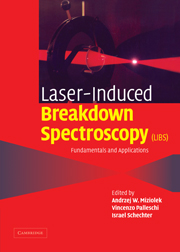Book contents
- Frontmatter
- Contents
- List of contributors
- Preface
- 1 History and fundamentals of LIBS
- 2 Plasma morphology
- 3 From sample to signal in laser-induced breakdown spectroscopy: a complex route to quantitative analysis
- 4 Laser-induced breakdown in gases: experiments and simulation
- 5 Analysis of aerosols by LIBS
- 6 Chemical imaging of surfaces using LIBS
- 7 Biomedical applications of LIBS
- 8 LIBS for the analysis of pharmaceutical materials
- 9 Cultural heritage applications of LIBS
- 10 Civilian and military environmental contamination studies using LIBS
- 11 Industrial applications of LIBS
- 12 Resonance-enhanced LIBS
- 13 Short-pulse LIBS: fundamentals and applications
- 14 High-speed, high-resolution LIBS using diode-pumped solid-state lasers
- 15 Laser-induced breakdown spectroscopy using sequential laser pulses
- 16 Micro LIBS technique
- 17 New spectral detectors for LIBS
- 18 Spark-induced breakdown spectroscopy: a description of an electrically generated LIBS-like process for elemental analysis of airborne particulates and solid samples
- Index
- References
17 - New spectral detectors for LIBS
Published online by Cambridge University Press: 08 August 2009
- Frontmatter
- Contents
- List of contributors
- Preface
- 1 History and fundamentals of LIBS
- 2 Plasma morphology
- 3 From sample to signal in laser-induced breakdown spectroscopy: a complex route to quantitative analysis
- 4 Laser-induced breakdown in gases: experiments and simulation
- 5 Analysis of aerosols by LIBS
- 6 Chemical imaging of surfaces using LIBS
- 7 Biomedical applications of LIBS
- 8 LIBS for the analysis of pharmaceutical materials
- 9 Cultural heritage applications of LIBS
- 10 Civilian and military environmental contamination studies using LIBS
- 11 Industrial applications of LIBS
- 12 Resonance-enhanced LIBS
- 13 Short-pulse LIBS: fundamentals and applications
- 14 High-speed, high-resolution LIBS using diode-pumped solid-state lasers
- 15 Laser-induced breakdown spectroscopy using sequential laser pulses
- 16 Micro LIBS technique
- 17 New spectral detectors for LIBS
- 18 Spark-induced breakdown spectroscopy: a description of an electrically generated LIBS-like process for elemental analysis of airborne particulates and solid samples
- Index
- References
Summary
Chapter organization
The purpose of this chapter is to provide the reader with an evaluation of new commercial echelle spectrometers equipped with charge transfer device (CTD) detectors for laser-induced breakdown spectroscopy (LIBS). Because it is difficult to separate the detector from the dispersion optics, a brief review of detectors, spectrometers and multichannel detection used in LIBS is given in Section 17.3. An evaluation of the echelle spectrometer/intensified charge coupled device (ICCD) performances is carried out in Section 17.4 in terms of plasma diagnostics (temperature, electron density) and spectrochemical analysis (wavelength coverage, spectral response, and detection limit). The advantages and limitations of such a system are discussed in Section 17.5. In order to provide a critical evaluation of the echelle spectrometer for LIBS applications, the performance of an echelle spectrometer coupled with an ICCD detector is compared with one equipped with an interline CCD camera in Section 17.6. Finally, a summary is presented in Section 17.7.
Introduction
Laser-induced plasma spectroscopy (LIPS), also known as laser-induced breakdown spectroscopy (LIBS), is a form of atomic emission spectroscopy (AES). LIBS is being used as an analytical method by a growing number of research groups. The growing interest in LIBS, particularly in the past decade, has led to an increasing number of publications on its applications, both in the laboratory and in industry. Despite all these activities, the LIBS technique is still not widely accepted in analytical chemistry. Nevertheless, LIP spectrochemical analysis has become an important tool for answering chemical questions and diagnosing industrial problems.
Information
- Type
- Chapter
- Information
- Laser Induced Breakdown Spectroscopy , pp. 556 - 584Publisher: Cambridge University PressPrint publication year: 2006
